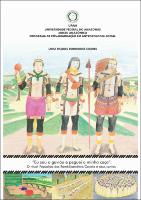| ???jsp.display-item.social.title??? |


|
Please use this identifier to cite or link to this item:
https://tede.ufam.edu.br/handle/tede/6878Full metadata record
| DC Field | Value | Language |
|---|---|---|
| dc.creator | Soares, Lígia Raquel Rodrigues | - |
| dc.creator.Lattes | http://lattes.cnpq.br/1114793323573199 | por |
| dc.contributor.advisor1 | Montardo, Deise Lucy Oliveira | - |
| dc.contributor.advisor1Lattes | http://lattes.cnpq.br/6344437017920336 | por |
| dc.contributor.advisor2 | Seeger, Anthony | - |
| dc.contributor.advisor2Lattes | http://lattes.cnpq.br/9272381103580919 | por |
| dc.contributor.advisor-co1 | Giraldin, Odair | - |
| dc.contributor.advisor-co1Lattes | http://lattes.cnpq.br/6898659315585888 | por |
| dc.contributor.referee1 | Bastos, Rafael José de Menezes | - |
| dc.contributor.referee1Lattes | http://lattes.cnpq.br/8219997657167540 | por |
| dc.contributor.referee2 | Santos, Gilton Mendes dos | - |
| dc.contributor.referee2Lattes | http://lattes.cnpq.br/8884263402852992 | por |
| dc.contributor.referee3 | Bruno, Ana Carla dos | - |
| dc.contributor.referee4 | Seeger, Anthony | - |
| dc.contributor.referee4Lattes | http://lattes.cnpq.br/9272381103580919 | por |
| dc.date.issued | 2015-08-28 | - |
| dc.identifier.citation | SOARES, Lígia Raquel Rodrigues. “Eu sou o gavião e peguei a minha caça”. O ritual Pepcahàc dos Ràmkôkamẽkra/Canela e seus cantos. 2015. 360 f. Tese (Doutorado em Antropologia Social) - Universidade Federal do Amazonas, Manaus, 2015. | por |
| dc.identifier.uri | https://tede.ufam.edu.br/handle/tede/6878 | - |
| dc.description.resumo | Esta tese tem como ponto principal a etnografia do ritual Pepcahàc dos Ràmkôkamẽkra/Canela, povo Jê do Brasil Central, e seus cantos. Considerado como “Festa de Gavião”, este é um ritual que trata da iniciação e formação masculina e tem como um dos pontos principais a formação de corpos e pessoas preparados para enfrentar a vida adulta com a força da onça e a fortaleza da pedra. Construir pessoas e corpos é viver momentos de liminaridade, junto aos espíritos e a outros seres, os quais podem ser “Outros”, mas que em determinados momentos podem ser “Nós”, especialmente no compartilhamento de poderes para a sustentação de todos os seres. E uma das maneiras de sustentar esses corpos é através dos cantos os quais possibilitam a interação com tais forças, mas também a alegria necessária para manter e reproduzir vidas. Parte-se do ritual do Pepcahàc para descrever o universo músico-ritual dos Ràmkôkamẽkra/Canela e suas classificações que se constitui numa teia densa de sistemas cancionais, instrumentos musicais, adornos, performances, pinturas corporais, resguardos, relações de parentesco e amizades formais essenciais para a constituição do sujeito e do coletivo desses povos. Com a análise dos conjuntos cancionais presentes no repertório do sistema cancional do Pepcahàc, torna-se possível compreender toda a riqueza musical desse sistema que tem, como um de seus objetivos maiores, construir sujeitos resistentes e fortalecer o coletivo, renovando e reforçando as estratégias utilizadas também para a convivência entre os diferentes povos reunidos na aldeia Escalvado. | por |
| dc.description.abstract | This thesis has as main point ethnography Pepcahàc ritual of the Ràmkôkamẽkra/Canela, a Gê speaking people of Central Brazil and its musics. Regarded as "Hawk´s Party", this is a ritual that deals with male initiation and training. One of its main targets is the formation of bodies and people prepared to face adulthood with the strength of jaguar and the endurance of stone. To produce people and bodies goes to live moments of liminality, near to the spirits and other beings, which may be sometimes “Others, but another one, maybe an “We”, especially in the sharing of powers to the support of all beings. And one of the ways to support these bodies is through the musics that enable both the interaction with such powers, and with the happiness needed to maintain and reproduce whole life. Starting from the pep-cahàc ritual, goes to describe the musical-ritual universe of Ràmkôkamẽkra/Canela which is a dense web of cancionais systems, performances, body ornaments, body painting, body restrictions, kinship relationship and formal friendships, which are central for the constitution either the subject or the collectivity of these people. With the analysis of the Pepcahàc cancional system and its cancional sets, we can understand the musical richness of that system who has, as one of its major goals, build resistant persons and strengthen the collective, renewing and strengthening the strategies also used for coexistence between different people gathered in the village Escalvado. | eng |
| dc.description.sponsorship | CAPES - Coordenação de Aperfeiçoamento de Pessoal de Nível Superior | por |
| dc.description.sponsorship | FAPEAM - Fundação de Amparo à Pesquisa do Estado do Amazonas | por |
| dc.format | application/pdf | * |
| dc.thumbnail.url | https://tede.ufam.edu.br//retrieve/27279/Tese_L%c3%adgiaSoares_PPGAS.jpg | * |
| dc.language | por | por |
| dc.publisher | Universidade Federal do Amazonas | por |
| dc.publisher.department | Museu Amazônico | por |
| dc.publisher.country | Brasil | por |
| dc.publisher.initials | UFAM | por |
| dc.publisher.program | Programa de Pós-graduação em Antropologia Social | por |
| dc.rights | Acesso Aberto | por |
| dc.subject | Povos indígenas Jë | por |
| dc.subject | Povos Timbira | por |
| dc.subject | Ritual Indígena | por |
| dc.subject | Etnomusicologia | por |
| dc.subject | Ritual de Iniciação Masculina | por |
| dc.subject.cnpq | CIÊNCIAS HUMANAS: ANTROPOLOGIA: ETNOLOGIA INDÍGENA | por |
| dc.title | “Eu sou o gavião e peguei a minha caça”. O ritual Pepcahàc dos Ràmkôkamẽkra/Canela e seus cantos | por |
| dc.title.alternative | "I'm the hawk and have caught my hunting". The Ràmkôkamẽkra/Canela's Pepcahác ritual and its songs | eng |
| dc.type | Tese | por |
| Appears in Collections: | Doutorado em Antropologia Social | |
Files in This Item:
| File | Description | Size | Format | |
|---|---|---|---|---|
| Tese_LígiaSoares_PPGAS | 17.04 MB | Adobe PDF |  Download/Open Preview |
Items in DSpace are protected by copyright, with all rights reserved, unless otherwise indicated.




